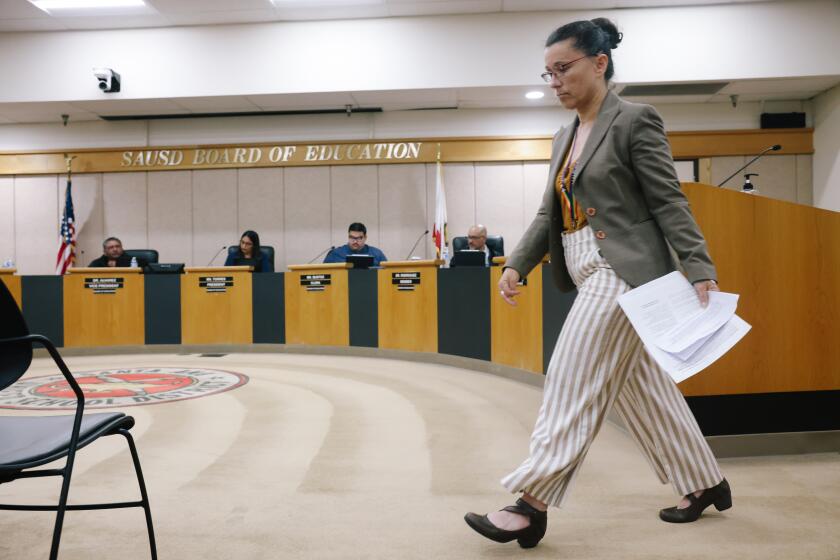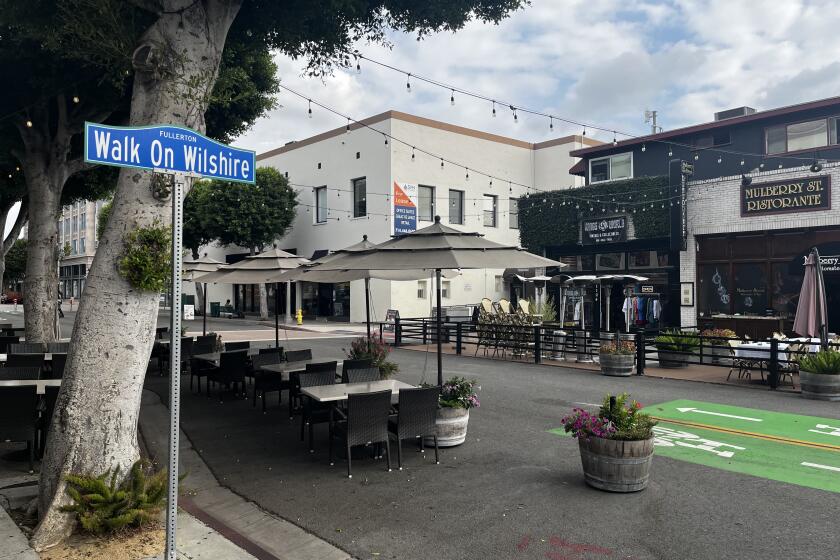New exhibit in Anaheim tells stories of O.C.-based Japanese Americans incarcerated during World War II
- Share via
For Patti Hirahara, the latest exhibition at Muzeo Museum and Cultural Center is the fulfillment of a 20-year dream.
A lifelong Anaheim resident, Hirahara had been collecting photographs and memorabilia from her family dating back more than 100 years, including photos taken during her father’s incarceration at Heart Mountain Relocation Center in Wyoming during World War II.
Some of that memorabilia is on display — along with interviews, photos and artifacts from 13 other families — in “I am an American: Japanese American Incarceration in a Time of Fear,” on view at Muzeo through Nov. 3.
“It’s remarkable,” said Hirahara, 64. “Nobody would expect this from Anaheim, but this community came together. Overall, it tells about the different families that were willing to do oral histories. How families show their resilience, what they were able to achieve after the war. It’s a testament to this community.”
After the outbreak of World War II, President Franklin D. Roosevelt issued Executive Order 9066 in February 1942. The order authorized and directed the Secretary of War and military commanders to “prescribe military areas” within the United States “from which any or all persons may be excluded.”
This resulted in approximately 120,000 Japanese-born residents and Japanese Americans being forced from their homes and relocated to incarceration camps in some of the most desolate areas of the United States. Ten official incarceration camps were built (there were additional camps built for “enemy aliens”), including the largest one in Poston, Ariz., which detained most of the Japanese Americans living in Anaheim and Orange County, according to the organizers of the exhibit.
“There was no rhyme or reason in terms of where the families went,” Hirahara said.
Before internment, Anaheim was home for nearly 100 Japanese American households, who had established their own tight-knit community, according to the exhibit. All of this was lost between February 1942 and November 1945.
After the camps were closed a few months after the end of World War II, many Japanese Americans returned to find they had lost their homes, farms and property because of theft, and many were not allowed to own real estate in this country.
The exhibition chronicles the years of incarceration and sheds a rare light on what life was like at Poston War Relocation Center, as it was officially called. Poston was the largest of the Japanese American incarceration camps, and it was comprised of three groups of barracks: Poston I, II and III. Or, as they were coined by the residents: “Roastin’,” “Toastin’ ” and “Dustin’.” Poston was a hot, dry and dusty place.
A life-size, 16-foot-by-25-foot barrack has been re-created in the galleries, and it demonstrates the cramped living quarters and lack of privacy in the camps.
During its peak, Poston held about 18,000 Japanese Americans, making it the third largest “city” in Arizona in 1942, according to the exhibit.
Dozens of black and white photographs reflect what Poston looked like at the time. Old suitcases, blankets and an antique typewriter are on display, as well as games, sculptures and watercolor paintings made by the residents.
About a dozen oral histories from survivors have been captured on video, and they play on touch screens located throughout the 5,000-square-foot exhibit. Surrounding the videos are descriptions and memorabilia from the survivors’ families.
“Family stories became our core part of our exhibit,” said Jane Newell, heritage services manager for the Anaheim Public Library. She and Joyce Franklin, a longtime curator for Muzeo and its predecessor, the Anaheim Museum, helped organize the exhibition, which is a joint project of Muzeo and the Anaheim Public Library. The National Park Service and its Japanese American Confinement Sites Grant also helped fund this show.
Some interesting slices of life include narrative accounts by Nancy Eagan (formerly Sakayeda), who grew up on her family’s chicken farm in west Anaheim. In 1965, she received a $10,000 loan to start Asahi Beauty Salon, which is still in business under Eagan’s ownership at 2939 W. Ball Road.
Michael Matsuda was born to parents incarcerated at Poston. He got his name from a landlord who was willing to rent to his parents at a time when many still held prejudice against Japanese Americans. He would grow up to become a teacher and is currently superintendent of the Anaheim Union High School District.
Carl Yoshimine was incarcerated as a young man at Poston. He recalls how the Japanese American internees tried to create a normal life with sports, movies, dances, a weekly newspaper and shopping through the Sears, Roebuck and Co. catalog. Yoshimine went on to become minister at the Anaheim Japanese Free Methodist Church from 1974 to 1988.
“I am an American” also details the heroic actions of the U.S. Army’s 442nd Regiment, which was composed almost entirely of second-generation Japanese Americans. The 442nd fought primarily in the European theater of World War II, and is the most decorated unit in U.S. military history. The regiment’s motto was “Go for Broke.” They saw heavy combat and risked their lives daily, ultimately receiving 18,143 awards, including 9,485 Purple Hearts, 21 Medals of Honor and the Congressional Gold Medal. One of those medals is on display in the Muzeo galleries.
Last but not least, the exhibition also recounts the lives of Japanese American Anaheim residents in the years after incarceration. Many have proceeded to live successful lives, contributing to public service, education, the aerospace industry, the Space Shuttle program, journalism and religious life.
“The early Anaheim families were here before, as well as after,” Hirahara said. “Anaheim became the hub for the Japanese American community.”
Organizers say this exhibition is important for several reasons. First, it’s one of the only museum exhibitions to date to thoroughly explore the Poston incarceration experience.
Second, this is the first and biggest of its kind in Orange County. “It tells the story of the residents of Orange County, and specifically Anaheim itself, that were incarcerated,” said Bill Bailor, chief executive officer of Muzeo.
“That gives it a very local feel, which is completely in line with the vision of the museum, to make sure the museum is a community resource. To bring things here that the community has some stake in, or they see themselves in — there’s a takeaway that makes it personal.”
Third, a lot of visitors have remarked, “We didn’t even know this happened,” according to Newell. It’s an important chapter in American history that’s not always covered in the history books.
Fourth, many of the incarcerated are passing away, and the exhibit is a chance to recall their stories with significant anniversaries occurring.
Finally, there are echoes and resonances in current events, with the extended detention of migrants at the U.S.-Mexico border, squalid living conditions there and children being separated from their parents.
“It’s not the same necessarily — people being removed from their homes and put into camps, with only a brief amount of time to collect limited belongings,” Bailor said. “That, of course, is not happening, but the distrust of immigrants or foreigners is certainly echoed in this exhibit, as in current events. Visitors of all backgrounds have mentioned that to the staff.
“There are things in here we continue to wrestle with and continue to be educated about, because some of these themes we’re still dealing with today.”
Muzeo is sponsoring an art and education series in conjunction with the exhibit that starts later this month and continues through October. On Sept. 21, Muzeo will host a traditional Japanese tea ceremony lead by expert Sochi Nomoto. On Oct. 5, Muzeo will present a free performing arts day, with taiko drummers, samurai demonstrations and origami lessons.
And on Oct 19, Muzeo is hosting an internee who will speak about his experience, followed by a screening of “And Then They Came for Us,” featuring actor and activist George Takei.
IF YOU GO
What: “I am an American: Japanese Incarceration in a Time of Fear”
Where: Muzeo Museum and Cultural Center, 241 S. Anaheim Blvd., Anaheim
When: 10 a.m. to 5 p.m., Wednesday to Sunday, now through Nov. 3
Cost: $10 adults, $8 seniors, students and military, $7 children
Information: (714) 765-6450 or muzeo.org
All the latest on Orange County from Orange County.
Get our free TimesOC newsletter.
You may occasionally receive promotional content from the Daily Pilot.




